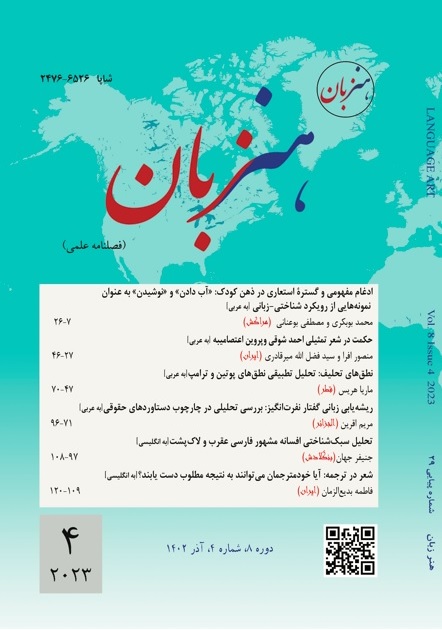ادغام مفهومی و گسترۀ استعاری در ذهن کودک: «آب دادن» و «نوشیدن» به عنوان نمونههایی از رویکرد شناختی-زبانی
DOI::
https://doi.org/10.22046/LA.2023.19کلمات کلیدی:
استعاره مفهومی, زبانشناسی شناختی, ادغام مفهومی, اکتساب استعاریچکیده
این پژوهش به بررسی رابطۀ بین «ادغام مفهومی» و «گسترۀ استعاری» در ذهن کودک میپردازد. این مطالعه بر پایۀ یک تحقیق میدانی است که رفتار استعاری یک نمونه تصادفی متشکل از ۶۴ شرکتکننده (به تعداد مساوی دختر و پسر) در بازۀ سنی ۴ تا ۷ سال را پیگیری کرده است. شرکتکنندگان به چهار گروه تقسیم شدند: کودکان پیشدبستانی و دانشآموزان سال اول ابتدایی در بخشهای آموزشی دولتی و خصوصی در بافت آموزشی مراکش. برای دستیابی به هدف فوق، یک آزمون ادراکی-زبانی طراحی شد که رابطه بین ادغام مفهومی و گسترۀ استعاری کودک را به طور کلی میسنجد و به طور خاص، نمونههای «آب دادن» و «نوشیدن» را به عنوان مثال بررسی میکند و همچنین مسیرهایی را که این ادغام استعاری ممکن است طی کند، آشکار میسازد. هدف کلی، نزدیکشدن به فرآیندهای تولید استعاره و بازنمایی آن در ذهن این گروه از شرکتکنندگان و توصیف مکانیسمهای شناختی پشت این عملیات ذهنی است که نحوۀ پردازش استعاره را در ابعاد مختلف روانشناختی، مفهومی و ادراکی نشان میدهد. این مطالعه به این نتیجه رسید که ادغام مفهومی، اساس گسترۀ استعاری برای کودک است، با تفاوتهای نسبی بین شرکتکنندگان که به متغیر سن مربوط میشود: هرچه سن شرکتکننده کمتر باشد، میزان یکپارچهسازی (ادغام) وسیعتر است. در ارتباط با مسیر پیوند دو تجربه، نتایج نشان داد که پیوند استعاری از تجربهای ناشی میشود که بیشترین «تجسد» را دارد، همانگونه که در ادبیات پارادایم شناختی تجسدیافته منعکس شده است و این یافته با فرضیه «ذهن تجسدیافته» همسو است.
مراجع
Asmuth, J., & Gentner, D. (2017). Metaphoric extension, relational categories, and abstraction. Language, Cognition and Neuroscience, 34(10), 1298–1307.
Boot, I., & Pecher, D. (2010). Similarity is closeness: Metaphorical mapping in a conceptual task. The Quarterly Journal of Experimental Psychology, 63(5), 942–954.
Boroditsky, L. (2000). Metaphoric structuring: Understanding time through spatial metaphors. Cognition, 75(1), 1–28.
Bowdle, B., Gentner, D., Wolff, P., & Boronat, C. (2001). Metaphor is like analogy. In D. Gentner, K. J. Holyoak, & B. N. Kokinov (Eds.), The analogical mind: Perspectives from cognitive science (pp. 199–253). The MIT Press.
Coulson, S., & Oakley, T. (2000). Blending basics. Cognitive Linguistics, 11(2), 175–196.
Fauconnier, G. (1985). Mental spaces: Aspects of meaning construction in natural language. Cambridge University Press.
Fauconnier, G. (1997). Mappings in thought and language. Cambridge University Press.
Fauconnier, G. (2001). Conceptual blending and analogy. In D. Gentner, K. J. Holyoak, & B. N. Kokinov (Eds.), The analogical mind: Perspectives from cognitive science (pp. 255–285). The MIT Press.
Fauconnier, G., & Turner, M. (1998). Conceptual integration networks. Cognitive Science, 22(2), 133–187.
Fauconnier, G., & Turner, M. (2002). The way we think: Conceptual blending and the mind's hidden complexities. Basic Books.
Fauconnier, G., & Turner, M. (2003). Conceptual blending, form and meaning. Recherches en communication, 19(19), 57–86.
Fauconnier, G., & Turner, M. (2008). Rethinking metaphor. In R. W. Gibbs, Jr. (Ed.), The Cambridge handbook of metaphor and thought (pp. 53–66). Cambridge University Press.
Gentner, D. (1983). Structure-mapping: A theoretical framework for analogy. Cognitive Science, 7(2), 155–170.
Gentner, D. (1988). Metaphor as structure mapping: The relational shift. Child Development, 59(1), 47–59.
Gentner, D., & Imai, M. (1992). Is the future always ahead? Evidence for system-mappings in understanding space-time metaphors. Proceedings of the Fourteenth Annual Conference of the Cognitive Science Society, 510–515.
Gentner, D., & Namy, L. L. (1999). Comparison in the development of categories. Cognitive Development, 14(4), 487–513.
Gibbs, R. W., Jr. (1996). Why many concepts are metaphorical. Cognition, 61(3), 309–319.
Gibbs, R. W., Jr. (2006). Embodiment and cognitive science. Cambridge University Press.
Grady, J. (1997). Foundations of meaning: Primary metaphors and primary scenes [Unpublished doctoral dissertation]. University of California, Berkeley.
Grady, J. (2000). Cognitive mechanisms of conceptual integration. Cognitive Linguistics, 11(3-4), 335–345.
Grady, J. (2005). Primary metaphors as inputs to conceptual integration. Journal of Pragmatics, 37(10), 1595–1614.
Johnson, C. (1997). Metaphor vs. conflation in the acquisition of polysemy: The case of see. In M. K. Hiraga, C. Sinha, & S. Wilcox (Eds.), Cultural, typological, and psychological issues in cognitive linguistics (pp. 155–169). John Benjamins Publishing Company.
Kövecses, Z. (2010). Metaphor: A practical introduction (2nd ed.). Oxford University Press.
Kövecses, Z. (2020). Extended conceptual metaphor theory. Cambridge University Press.
Lakoff, G. (1986). Classifiers as a reflection of mind. Noun classes and categorization, 7, 13-51.
Lakoff, G. (1987). Women, fire, and dangerous things: What categories reveal about the mind. University of Chicago Press.
Lakoff, G. (1993). The contemporary theory of metaphor. In A. Ortony (Ed.), Metaphor and thought (2nd ed., pp. 202–251). Cambridge University Press.
Lakoff, G. (2008). The neural theory of metaphor. In R. W. Gibbs, Jr. (Ed.), The Cambridge handbook of metaphor and thought (pp. 17–38). Cambridge University Press.
Lakoff, G., & Johnson, M. (1980). Metaphors we live by. University of Chicago Press.
Lakoff, G., & Johnson, M. (1999). Philosophy in the flesh: The embodied mind and its challenge to Western thought. Basic Books.
McLeod, S. A. (2018, June 06). Jean Piaget's theory of cognitive development. Simply Psychology. https://www.simplypsychology.org/piaget.html
Oakley, T., & Pascual, E. (2017). Conceptual blending theory. In B. Dancygier (Ed.), The Cambridge handbook of cognitive linguistics (pp. 423–448). Cambridge University Press.
Wolff, P., & Gentner, D. (2011). Structure‐mapping in metaphor comprehension. Cognitive Science, 35(8), 1456–1488.
##submission.downloads##
چاپ شده
ارجاع به مقاله
شماره
نوع مقاله
مجوز
حق نشر 2023 Mohammed Boubekri, Mostafa Bouanani

این پروژه تحت مجوز بین المللی Creative Commons Attribution 4.0 می باشد.
فصلنامه هنر زبان یک مجله دسترسی آزاد است و مقالات پس از پذیرش در دسترس عموم قرار می گیرند و استفاده از آن با ذکر منبع آزاد است
